HR Strategy of Nestle
VerifiedAdded on 2023/06/13
|9
|2143
|282
AI Summary
The essay discusses the HR strategy of Nestle, a multinational company manufacturing packaged food. The company is committed to providing ideal working conditions and a healthy work culture to its workforce. The HR strategy focuses on high performance, high participation, and high-level commitment. The essay also outlines the HR challenges faced by the company and the key HR-based accomplishments if the HR strategy is successfully implemented.
Contribute Materials
Your contribution can guide someone’s learning journey. Share your
documents today.
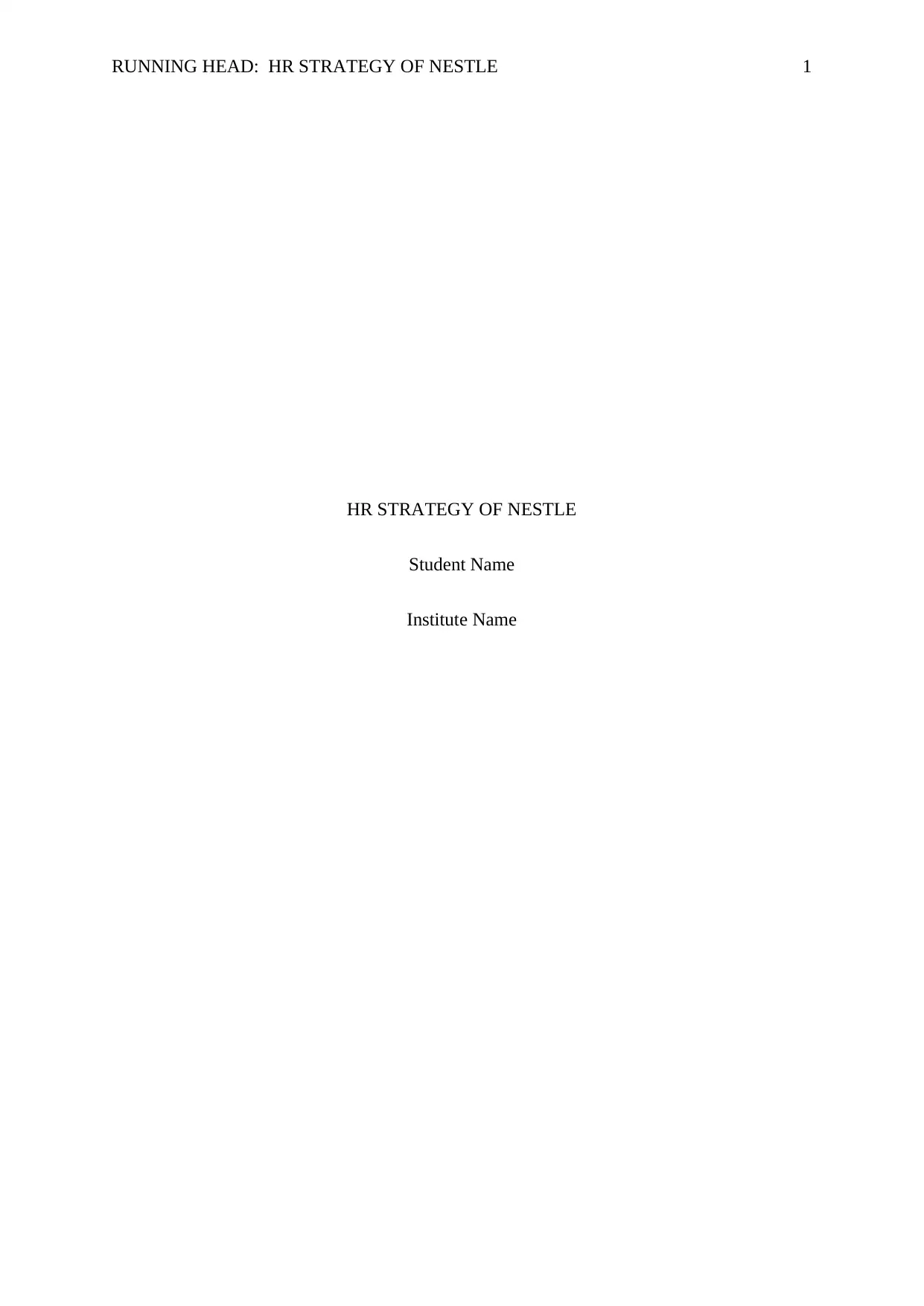
RUNNING HEAD: HR STRATEGY OF NESTLE 1
HR STRATEGY OF NESTLE
Student Name
Institute Name
HR STRATEGY OF NESTLE
Student Name
Institute Name
Secure Best Marks with AI Grader
Need help grading? Try our AI Grader for instant feedback on your assignments.
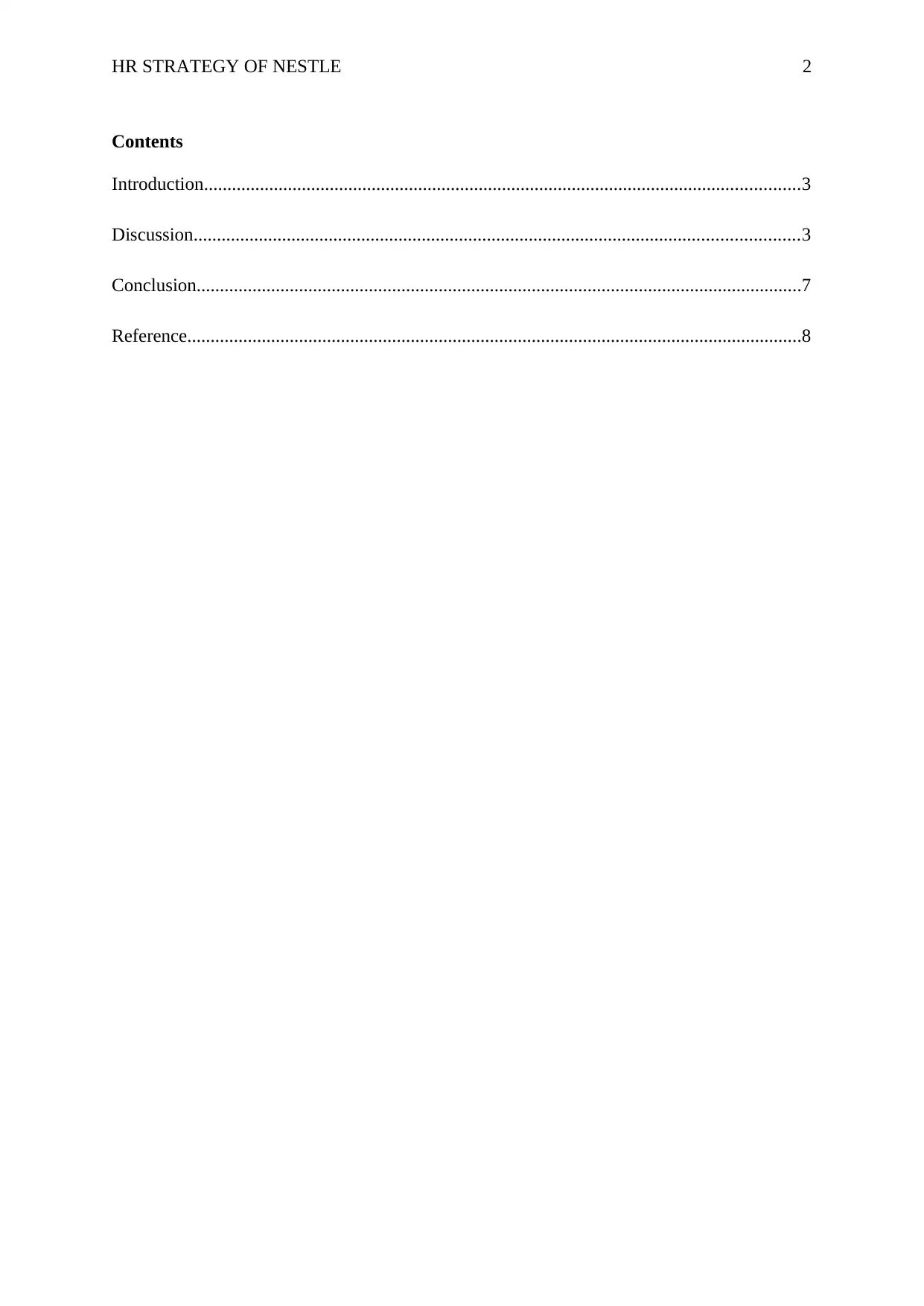
HR STRATEGY OF NESTLE 2
Contents
Introduction................................................................................................................................3
Discussion..................................................................................................................................3
Conclusion..................................................................................................................................7
Reference....................................................................................................................................8
Contents
Introduction................................................................................................................................3
Discussion..................................................................................................................................3
Conclusion..................................................................................................................................7
Reference....................................................................................................................................8
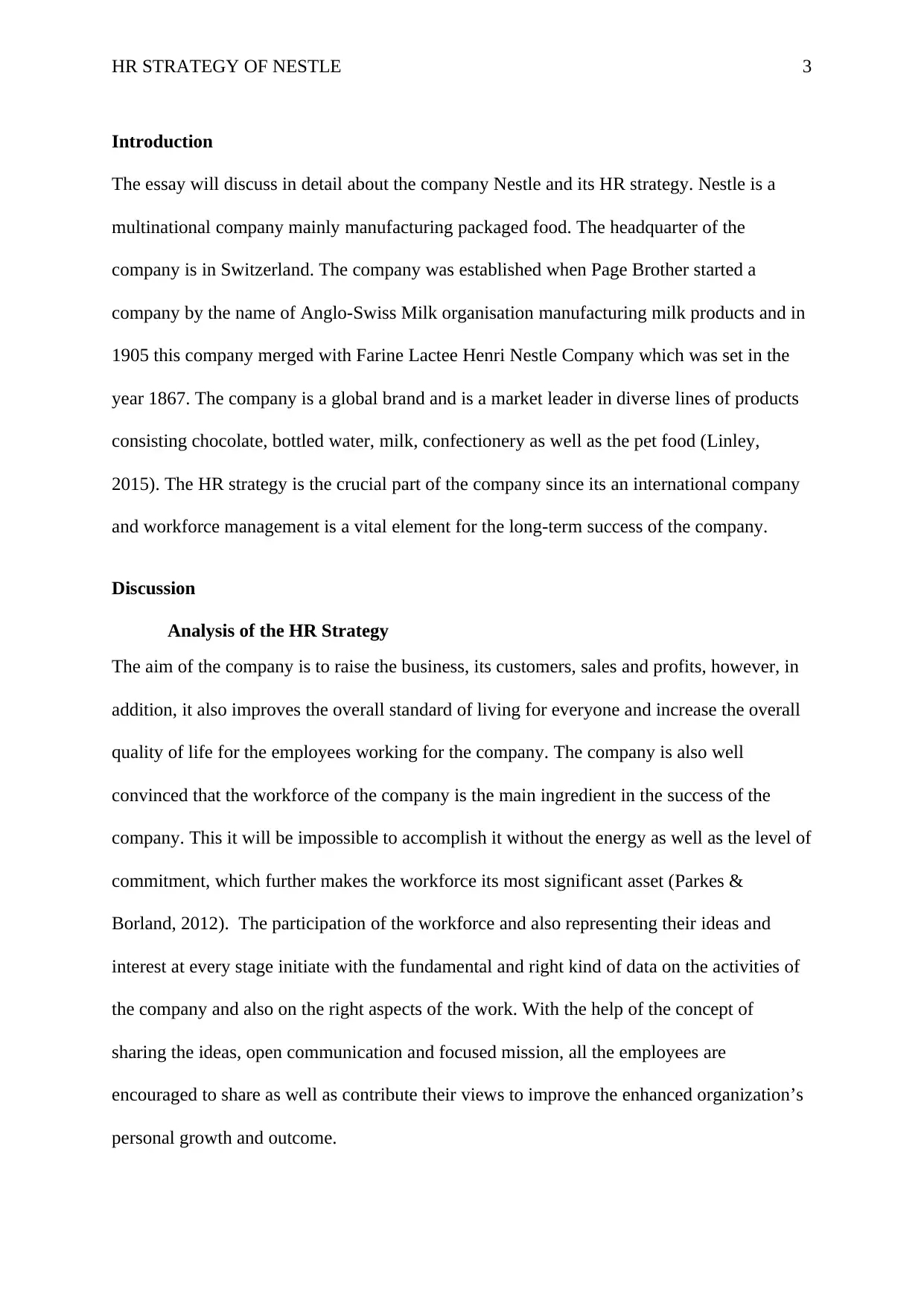
HR STRATEGY OF NESTLE 3
Introduction
The essay will discuss in detail about the company Nestle and its HR strategy. Nestle is a
multinational company mainly manufacturing packaged food. The headquarter of the
company is in Switzerland. The company was established when Page Brother started a
company by the name of Anglo-Swiss Milk organisation manufacturing milk products and in
1905 this company merged with Farine Lactee Henri Nestle Company which was set in the
year 1867. The company is a global brand and is a market leader in diverse lines of products
consisting chocolate, bottled water, milk, confectionery as well as the pet food (Linley,
2015). The HR strategy is the crucial part of the company since its an international company
and workforce management is a vital element for the long-term success of the company.
Discussion
Analysis of the HR Strategy
The aim of the company is to raise the business, its customers, sales and profits, however, in
addition, it also improves the overall standard of living for everyone and increase the overall
quality of life for the employees working for the company. The company is also well
convinced that the workforce of the company is the main ingredient in the success of the
company. This it will be impossible to accomplish it without the energy as well as the level of
commitment, which further makes the workforce its most significant asset (Parkes &
Borland, 2012). The participation of the workforce and also representing their ideas and
interest at every stage initiate with the fundamental and right kind of data on the activities of
the company and also on the right aspects of the work. With the help of the concept of
sharing the ideas, open communication and focused mission, all the employees are
encouraged to share as well as contribute their views to improve the enhanced organization’s
personal growth and outcome.
Introduction
The essay will discuss in detail about the company Nestle and its HR strategy. Nestle is a
multinational company mainly manufacturing packaged food. The headquarter of the
company is in Switzerland. The company was established when Page Brother started a
company by the name of Anglo-Swiss Milk organisation manufacturing milk products and in
1905 this company merged with Farine Lactee Henri Nestle Company which was set in the
year 1867. The company is a global brand and is a market leader in diverse lines of products
consisting chocolate, bottled water, milk, confectionery as well as the pet food (Linley,
2015). The HR strategy is the crucial part of the company since its an international company
and workforce management is a vital element for the long-term success of the company.
Discussion
Analysis of the HR Strategy
The aim of the company is to raise the business, its customers, sales and profits, however, in
addition, it also improves the overall standard of living for everyone and increase the overall
quality of life for the employees working for the company. The company is also well
convinced that the workforce of the company is the main ingredient in the success of the
company. This it will be impossible to accomplish it without the energy as well as the level of
commitment, which further makes the workforce its most significant asset (Parkes &
Borland, 2012). The participation of the workforce and also representing their ideas and
interest at every stage initiate with the fundamental and right kind of data on the activities of
the company and also on the right aspects of the work. With the help of the concept of
sharing the ideas, open communication and focused mission, all the employees are
encouraged to share as well as contribute their views to improve the enhanced organization’s
personal growth and outcome.
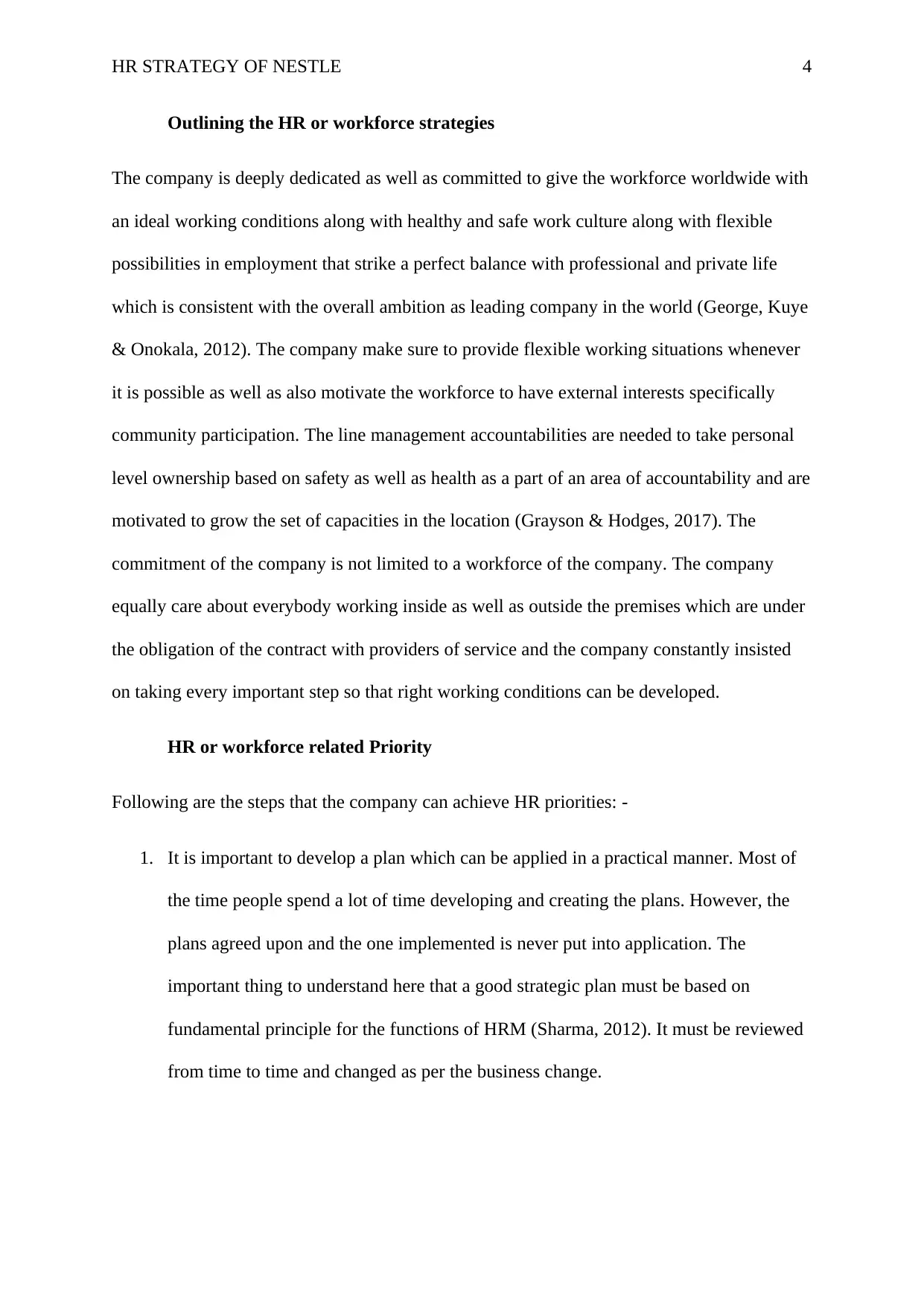
HR STRATEGY OF NESTLE 4
Outlining the HR or workforce strategies
The company is deeply dedicated as well as committed to give the workforce worldwide with
an ideal working conditions along with healthy and safe work culture along with flexible
possibilities in employment that strike a perfect balance with professional and private life
which is consistent with the overall ambition as leading company in the world (George, Kuye
& Onokala, 2012). The company make sure to provide flexible working situations whenever
it is possible as well as also motivate the workforce to have external interests specifically
community participation. The line management accountabilities are needed to take personal
level ownership based on safety as well as health as a part of an area of accountability and are
motivated to grow the set of capacities in the location (Grayson & Hodges, 2017). The
commitment of the company is not limited to a workforce of the company. The company
equally care about everybody working inside as well as outside the premises which are under
the obligation of the contract with providers of service and the company constantly insisted
on taking every important step so that right working conditions can be developed.
HR or workforce related Priority
Following are the steps that the company can achieve HR priorities: -
1. It is important to develop a plan which can be applied in a practical manner. Most of
the time people spend a lot of time developing and creating the plans. However, the
plans agreed upon and the one implemented is never put into application. The
important thing to understand here that a good strategic plan must be based on
fundamental principle for the functions of HRM (Sharma, 2012). It must be reviewed
from time to time and changed as per the business change.
Outlining the HR or workforce strategies
The company is deeply dedicated as well as committed to give the workforce worldwide with
an ideal working conditions along with healthy and safe work culture along with flexible
possibilities in employment that strike a perfect balance with professional and private life
which is consistent with the overall ambition as leading company in the world (George, Kuye
& Onokala, 2012). The company make sure to provide flexible working situations whenever
it is possible as well as also motivate the workforce to have external interests specifically
community participation. The line management accountabilities are needed to take personal
level ownership based on safety as well as health as a part of an area of accountability and are
motivated to grow the set of capacities in the location (Grayson & Hodges, 2017). The
commitment of the company is not limited to a workforce of the company. The company
equally care about everybody working inside as well as outside the premises which are under
the obligation of the contract with providers of service and the company constantly insisted
on taking every important step so that right working conditions can be developed.
HR or workforce related Priority
Following are the steps that the company can achieve HR priorities: -
1. It is important to develop a plan which can be applied in a practical manner. Most of
the time people spend a lot of time developing and creating the plans. However, the
plans agreed upon and the one implemented is never put into application. The
important thing to understand here that a good strategic plan must be based on
fundamental principle for the functions of HRM (Sharma, 2012). It must be reviewed
from time to time and changed as per the business change.
Secure Best Marks with AI Grader
Need help grading? Try our AI Grader for instant feedback on your assignments.
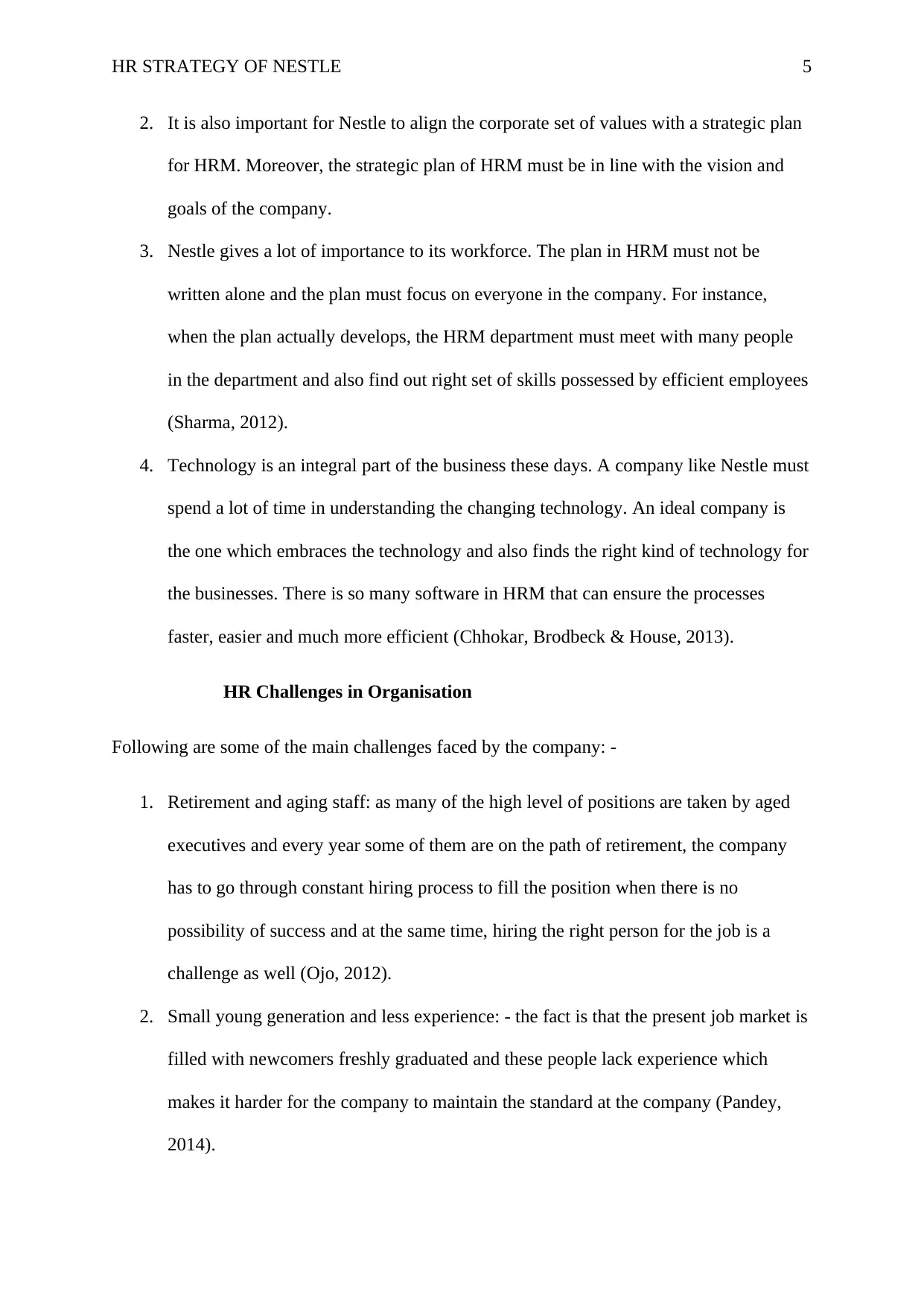
HR STRATEGY OF NESTLE 5
2. It is also important for Nestle to align the corporate set of values with a strategic plan
for HRM. Moreover, the strategic plan of HRM must be in line with the vision and
goals of the company.
3. Nestle gives a lot of importance to its workforce. The plan in HRM must not be
written alone and the plan must focus on everyone in the company. For instance,
when the plan actually develops, the HRM department must meet with many people
in the department and also find out right set of skills possessed by efficient employees
(Sharma, 2012).
4. Technology is an integral part of the business these days. A company like Nestle must
spend a lot of time in understanding the changing technology. An ideal company is
the one which embraces the technology and also finds the right kind of technology for
the businesses. There is so many software in HRM that can ensure the processes
faster, easier and much more efficient (Chhokar, Brodbeck & House, 2013).
HR Challenges in Organisation
Following are some of the main challenges faced by the company: -
1. Retirement and aging staff: as many of the high level of positions are taken by aged
executives and every year some of them are on the path of retirement, the company
has to go through constant hiring process to fill the position when there is no
possibility of success and at the same time, hiring the right person for the job is a
challenge as well (Ojo, 2012).
2. Small young generation and less experience: - the fact is that the present job market is
filled with newcomers freshly graduated and these people lack experience which
makes it harder for the company to maintain the standard at the company (Pandey,
2014).
2. It is also important for Nestle to align the corporate set of values with a strategic plan
for HRM. Moreover, the strategic plan of HRM must be in line with the vision and
goals of the company.
3. Nestle gives a lot of importance to its workforce. The plan in HRM must not be
written alone and the plan must focus on everyone in the company. For instance,
when the plan actually develops, the HRM department must meet with many people
in the department and also find out right set of skills possessed by efficient employees
(Sharma, 2012).
4. Technology is an integral part of the business these days. A company like Nestle must
spend a lot of time in understanding the changing technology. An ideal company is
the one which embraces the technology and also finds the right kind of technology for
the businesses. There is so many software in HRM that can ensure the processes
faster, easier and much more efficient (Chhokar, Brodbeck & House, 2013).
HR Challenges in Organisation
Following are some of the main challenges faced by the company: -
1. Retirement and aging staff: as many of the high level of positions are taken by aged
executives and every year some of them are on the path of retirement, the company
has to go through constant hiring process to fill the position when there is no
possibility of success and at the same time, hiring the right person for the job is a
challenge as well (Ojo, 2012).
2. Small young generation and less experience: - the fact is that the present job market is
filled with newcomers freshly graduated and these people lack experience which
makes it harder for the company to maintain the standard at the company (Pandey,
2014).
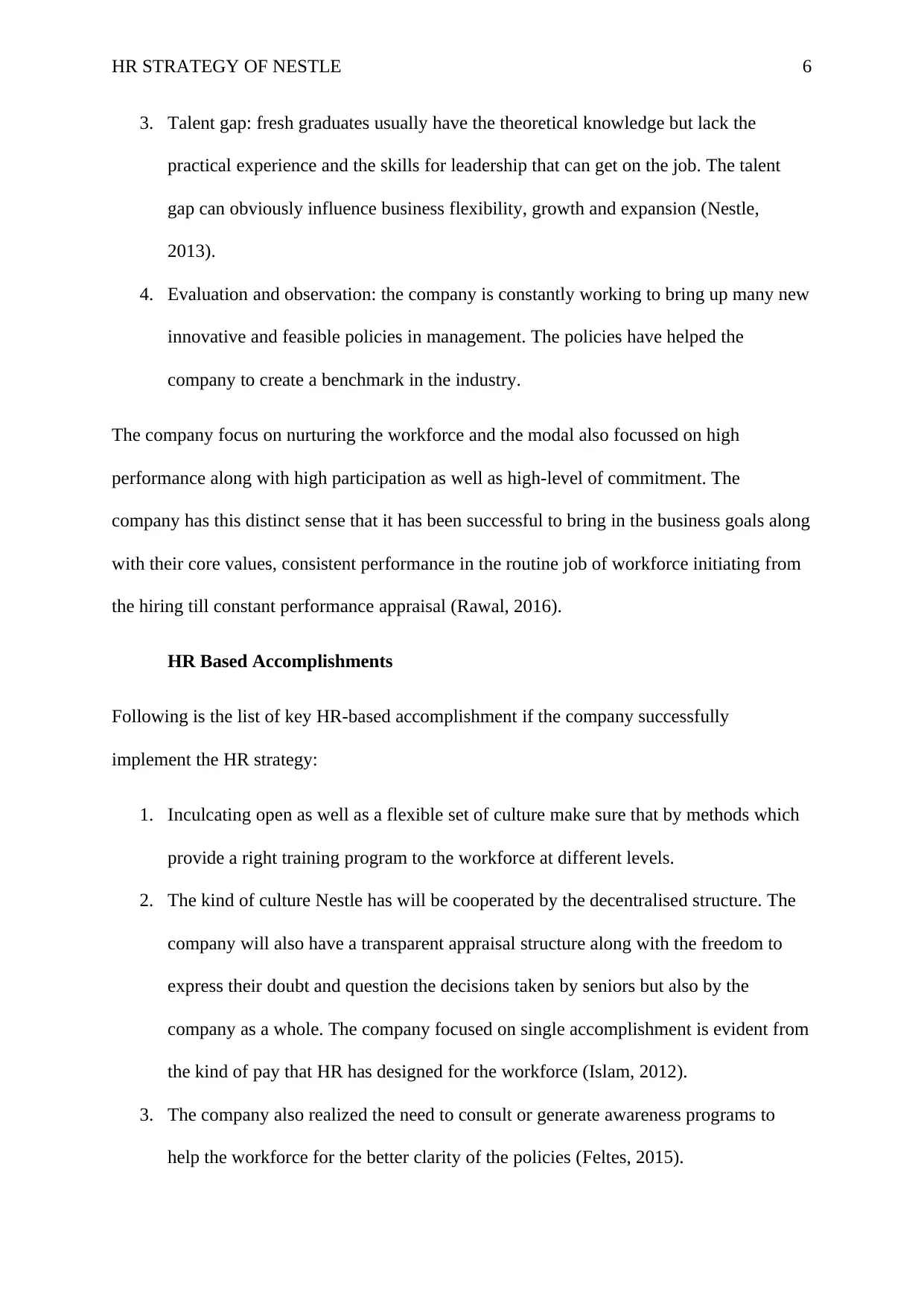
HR STRATEGY OF NESTLE 6
3. Talent gap: fresh graduates usually have the theoretical knowledge but lack the
practical experience and the skills for leadership that can get on the job. The talent
gap can obviously influence business flexibility, growth and expansion (Nestle,
2013).
4. Evaluation and observation: the company is constantly working to bring up many new
innovative and feasible policies in management. The policies have helped the
company to create a benchmark in the industry.
The company focus on nurturing the workforce and the modal also focussed on high
performance along with high participation as well as high-level of commitment. The
company has this distinct sense that it has been successful to bring in the business goals along
with their core values, consistent performance in the routine job of workforce initiating from
the hiring till constant performance appraisal (Rawal, 2016).
HR Based Accomplishments
Following is the list of key HR-based accomplishment if the company successfully
implement the HR strategy:
1. Inculcating open as well as a flexible set of culture make sure that by methods which
provide a right training program to the workforce at different levels.
2. The kind of culture Nestle has will be cooperated by the decentralised structure. The
company will also have a transparent appraisal structure along with the freedom to
express their doubt and question the decisions taken by seniors but also by the
company as a whole. The company focused on single accomplishment is evident from
the kind of pay that HR has designed for the workforce (Islam, 2012).
3. The company also realized the need to consult or generate awareness programs to
help the workforce for the better clarity of the policies (Feltes, 2015).
3. Talent gap: fresh graduates usually have the theoretical knowledge but lack the
practical experience and the skills for leadership that can get on the job. The talent
gap can obviously influence business flexibility, growth and expansion (Nestle,
2013).
4. Evaluation and observation: the company is constantly working to bring up many new
innovative and feasible policies in management. The policies have helped the
company to create a benchmark in the industry.
The company focus on nurturing the workforce and the modal also focussed on high
performance along with high participation as well as high-level of commitment. The
company has this distinct sense that it has been successful to bring in the business goals along
with their core values, consistent performance in the routine job of workforce initiating from
the hiring till constant performance appraisal (Rawal, 2016).
HR Based Accomplishments
Following is the list of key HR-based accomplishment if the company successfully
implement the HR strategy:
1. Inculcating open as well as a flexible set of culture make sure that by methods which
provide a right training program to the workforce at different levels.
2. The kind of culture Nestle has will be cooperated by the decentralised structure. The
company will also have a transparent appraisal structure along with the freedom to
express their doubt and question the decisions taken by seniors but also by the
company as a whole. The company focused on single accomplishment is evident from
the kind of pay that HR has designed for the workforce (Islam, 2012).
3. The company also realized the need to consult or generate awareness programs to
help the workforce for the better clarity of the policies (Feltes, 2015).
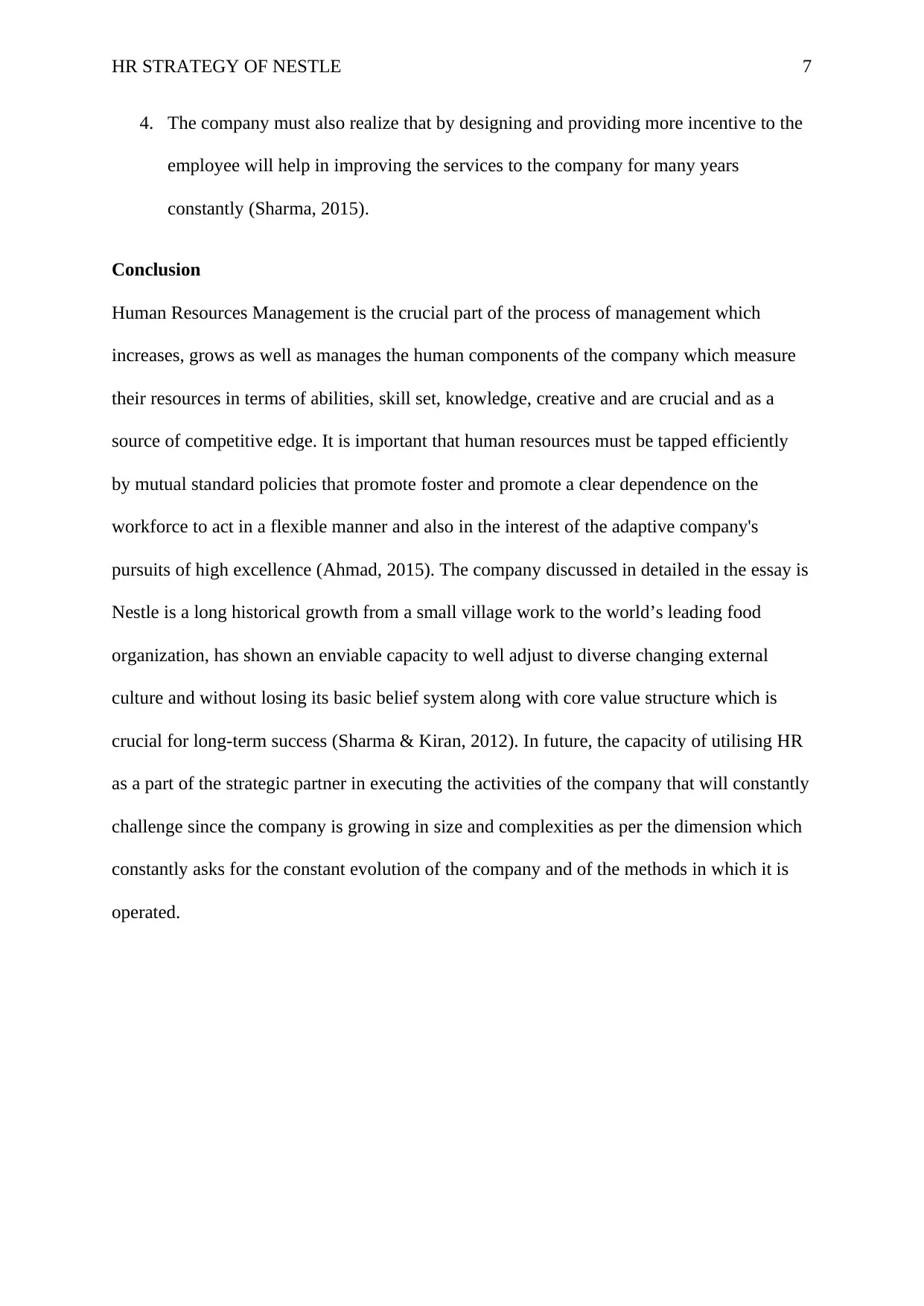
HR STRATEGY OF NESTLE 7
4. The company must also realize that by designing and providing more incentive to the
employee will help in improving the services to the company for many years
constantly (Sharma, 2015).
Conclusion
Human Resources Management is the crucial part of the process of management which
increases, grows as well as manages the human components of the company which measure
their resources in terms of abilities, skill set, knowledge, creative and are crucial and as a
source of competitive edge. It is important that human resources must be tapped efficiently
by mutual standard policies that promote foster and promote a clear dependence on the
workforce to act in a flexible manner and also in the interest of the adaptive company's
pursuits of high excellence (Ahmad, 2015). The company discussed in detailed in the essay is
Nestle is a long historical growth from a small village work to the world’s leading food
organization, has shown an enviable capacity to well adjust to diverse changing external
culture and without losing its basic belief system along with core value structure which is
crucial for long-term success (Sharma & Kiran, 2012). In future, the capacity of utilising HR
as a part of the strategic partner in executing the activities of the company that will constantly
challenge since the company is growing in size and complexities as per the dimension which
constantly asks for the constant evolution of the company and of the methods in which it is
operated.
4. The company must also realize that by designing and providing more incentive to the
employee will help in improving the services to the company for many years
constantly (Sharma, 2015).
Conclusion
Human Resources Management is the crucial part of the process of management which
increases, grows as well as manages the human components of the company which measure
their resources in terms of abilities, skill set, knowledge, creative and are crucial and as a
source of competitive edge. It is important that human resources must be tapped efficiently
by mutual standard policies that promote foster and promote a clear dependence on the
workforce to act in a flexible manner and also in the interest of the adaptive company's
pursuits of high excellence (Ahmad, 2015). The company discussed in detailed in the essay is
Nestle is a long historical growth from a small village work to the world’s leading food
organization, has shown an enviable capacity to well adjust to diverse changing external
culture and without losing its basic belief system along with core value structure which is
crucial for long-term success (Sharma & Kiran, 2012). In future, the capacity of utilising HR
as a part of the strategic partner in executing the activities of the company that will constantly
challenge since the company is growing in size and complexities as per the dimension which
constantly asks for the constant evolution of the company and of the methods in which it is
operated.
Paraphrase This Document
Need a fresh take? Get an instant paraphrase of this document with our AI Paraphraser
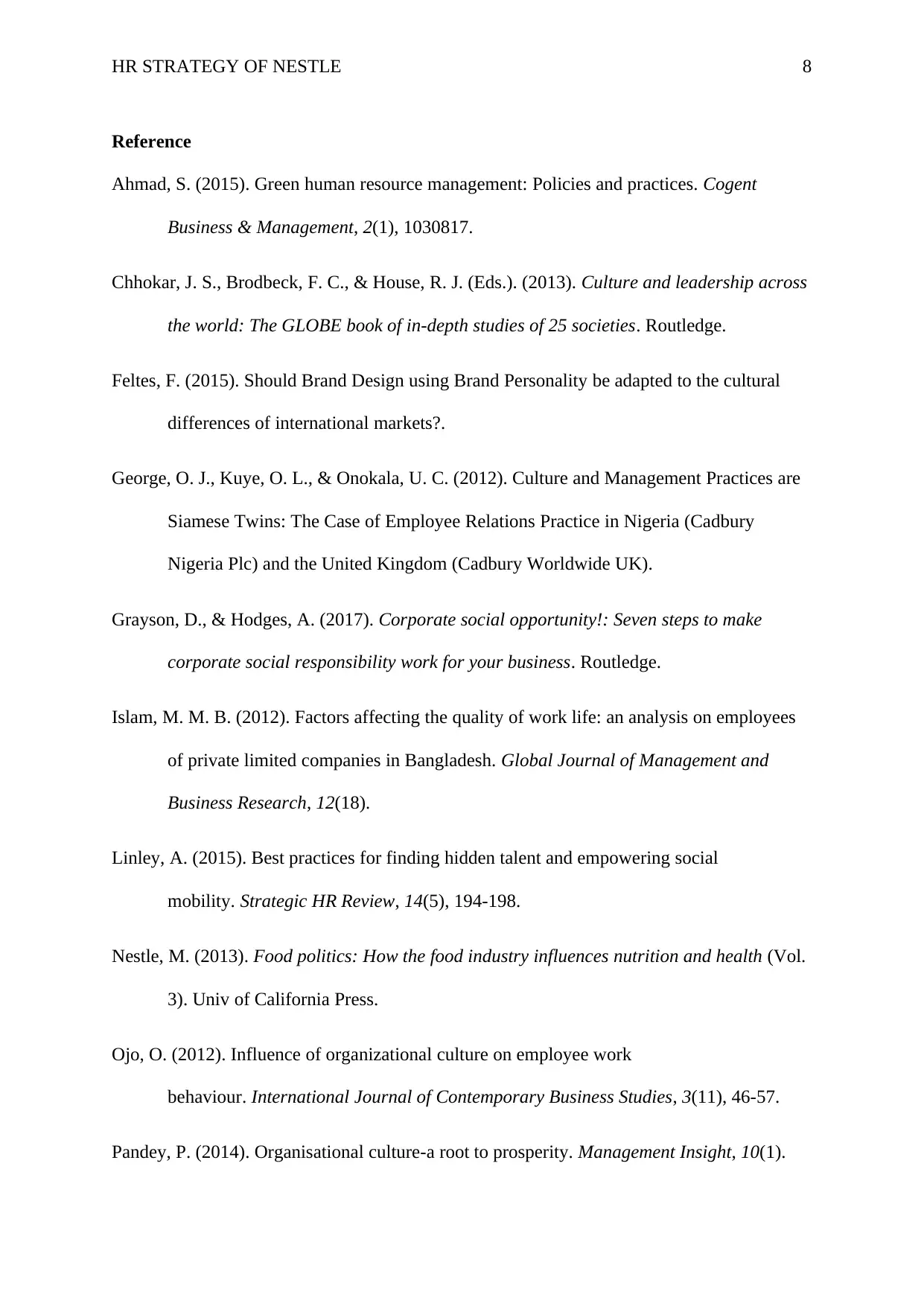
HR STRATEGY OF NESTLE 8
Reference
Ahmad, S. (2015). Green human resource management: Policies and practices. Cogent
Business & Management, 2(1), 1030817.
Chhokar, J. S., Brodbeck, F. C., & House, R. J. (Eds.). (2013). Culture and leadership across
the world: The GLOBE book of in-depth studies of 25 societies. Routledge.
Feltes, F. (2015). Should Brand Design using Brand Personality be adapted to the cultural
differences of international markets?.
George, O. J., Kuye, O. L., & Onokala, U. C. (2012). Culture and Management Practices are
Siamese Twins: The Case of Employee Relations Practice in Nigeria (Cadbury
Nigeria Plc) and the United Kingdom (Cadbury Worldwide UK).
Grayson, D., & Hodges, A. (2017). Corporate social opportunity!: Seven steps to make
corporate social responsibility work for your business. Routledge.
Islam, M. M. B. (2012). Factors affecting the quality of work life: an analysis on employees
of private limited companies in Bangladesh. Global Journal of Management and
Business Research, 12(18).
Linley, A. (2015). Best practices for finding hidden talent and empowering social
mobility. Strategic HR Review, 14(5), 194-198.
Nestle, M. (2013). Food politics: How the food industry influences nutrition and health (Vol.
3). Univ of California Press.
Ojo, O. (2012). Influence of organizational culture on employee work
behaviour. International Journal of Contemporary Business Studies, 3(11), 46-57.
Pandey, P. (2014). Organisational culture-a root to prosperity. Management Insight, 10(1).
Reference
Ahmad, S. (2015). Green human resource management: Policies and practices. Cogent
Business & Management, 2(1), 1030817.
Chhokar, J. S., Brodbeck, F. C., & House, R. J. (Eds.). (2013). Culture and leadership across
the world: The GLOBE book of in-depth studies of 25 societies. Routledge.
Feltes, F. (2015). Should Brand Design using Brand Personality be adapted to the cultural
differences of international markets?.
George, O. J., Kuye, O. L., & Onokala, U. C. (2012). Culture and Management Practices are
Siamese Twins: The Case of Employee Relations Practice in Nigeria (Cadbury
Nigeria Plc) and the United Kingdom (Cadbury Worldwide UK).
Grayson, D., & Hodges, A. (2017). Corporate social opportunity!: Seven steps to make
corporate social responsibility work for your business. Routledge.
Islam, M. M. B. (2012). Factors affecting the quality of work life: an analysis on employees
of private limited companies in Bangladesh. Global Journal of Management and
Business Research, 12(18).
Linley, A. (2015). Best practices for finding hidden talent and empowering social
mobility. Strategic HR Review, 14(5), 194-198.
Nestle, M. (2013). Food politics: How the food industry influences nutrition and health (Vol.
3). Univ of California Press.
Ojo, O. (2012). Influence of organizational culture on employee work
behaviour. International Journal of Contemporary Business Studies, 3(11), 46-57.
Pandey, P. (2014). Organisational culture-a root to prosperity. Management Insight, 10(1).

HR STRATEGY OF NESTLE 9
Parkes, C., & Borland, H. (2012). Strategic HRM: Transforming its responsibilities toward
ecological sustainability—the greatest global challenge facing
organizations. Thunderbird International Business Review, 54(6), 811-824.
Rawal, P. (2016). Indian Monk Who Wants A Billion-Dollar Company: A Yogic Business
Revolution. International Journal of Management Research and Reviews, 6(9), 1169.
Sharma, A., & Kiran, R. (2012). Corporate social responsibility initiatives of major
companies of India with focus on health, education and environment. African Journal
of Basic & Applied Sciences, 4(3), 95-105.
Sharma, D. (2012). Roles for HR professionals. Integral Review: A Journal of
Management, 5(2).
Sharma, S. (2015). Human Resources And Cultural Issues Impacting Post Merger Corporate
Objectivity. Scholedge International Journal of Management & Development ISSN
2394-3378, 1(2), 1-4.
Parkes, C., & Borland, H. (2012). Strategic HRM: Transforming its responsibilities toward
ecological sustainability—the greatest global challenge facing
organizations. Thunderbird International Business Review, 54(6), 811-824.
Rawal, P. (2016). Indian Monk Who Wants A Billion-Dollar Company: A Yogic Business
Revolution. International Journal of Management Research and Reviews, 6(9), 1169.
Sharma, A., & Kiran, R. (2012). Corporate social responsibility initiatives of major
companies of India with focus on health, education and environment. African Journal
of Basic & Applied Sciences, 4(3), 95-105.
Sharma, D. (2012). Roles for HR professionals. Integral Review: A Journal of
Management, 5(2).
Sharma, S. (2015). Human Resources And Cultural Issues Impacting Post Merger Corporate
Objectivity. Scholedge International Journal of Management & Development ISSN
2394-3378, 1(2), 1-4.
1 out of 9
Related Documents
Your All-in-One AI-Powered Toolkit for Academic Success.
+13062052269
info@desklib.com
Available 24*7 on WhatsApp / Email
![[object Object]](/_next/static/media/star-bottom.7253800d.svg)
Unlock your academic potential
© 2024 | Zucol Services PVT LTD | All rights reserved.




